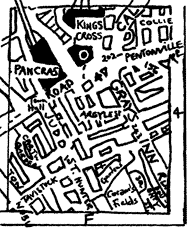
Literary London goes for an only slightly literary walk

On page 45 of my ancient edition of the A–Z, square 4F, densely packed and boasting both King’s Cross and St Pancras stations, is where the congested throats of the Caledonian, Euston, Gray’s Inn and Pentonville roads finally meet in one swirling bad-tempered junction. This teaming quadrant contains the redeveloped smoothness of new offices and pedestrian areas that are symbols of the area’s dramatic regeneration, mixed with seedy crumbling buildings, rundown pubs and derelict buildings; and like a lot of transport hubs, it’s also a place that everyone is trying to leave – and in a hurry, at that.
Rather perversely, then, I have always been slightly obsessed with this part of London, just on the edge of literary Bloomsbury, not quite in Camden, close to the City, but, overwhelmingly, a huge confluence of competing traffic streams. So, one blustery Saturday afternoon, I decided to pay it a visit in the name of this column.
At the top left-hand corner of 4F, as the thick swerve of Cally Road meets Pentonville, you can find Housmans Booksellers at 5 Caledonian Road. The shop was established in 1945 and specialises in radical books and periodicals. On the opposite side of the road is Keystone Crescent, a lovely half-moon of Georgian town houses that looks like something the developers forgot to knock down. It appears on the map as an unlikely and very delicate loop amidst the more definite straight lines and grid patterns that make up the surrounding streets.
Turn right now towards King’s Cross station and you will come to an island of buildings marooned between two busy rivers of traffic. On the Gray’s Inn Road side there are several abandoned shop fronts that I always look out for: ‘Dress Wright’, ‘The Eastern Eye’ and ‘Mole Jazz’. I’m particularly fond of the last of these, with its entirely suitable image of a mole playing a saxophone on its lime green sign, but I can’t imagine they will be allowed to stay there much longer. Several storeys above this grotty frontage sits a bizarre iron tower replete with its own weather vane, that I have never seen the like of elsewhere in London. It looks as if it would fit in well on top of a large ship with its porthole-style windows, although it also has something of the helter-skelter about it. (Does any reader know more about this? Do get in touch with LL if so.)
A few steps more takes you to Lewis Cubitt’s underrated King’s Cross terminal, a ‘relatively modest terminus […] adorned only by a simple Italian-style clock turret’ (1), which should soon be restored to its former glory thanks to plans to remove the unsightly plastic-looking entrance as part of the station’s revamp.
Hitchcock’s The Ladykillers was both set and filmed in King’s Cross, and behind the station is Cheny Road (formerly Cheny Street) where the famous robbery scene was shot. Filming also took place in nearby Argyle Street (also in our illustrious A–Z square) for the front door of Mrs Wilberforce’s house and in these shots the St Pancras tower can be seen in the background.(2)
Just a little further along from Cubitt’s masterpiece, then, is the splendour of George Gilbert Scott’s neo-Gothic St Pancras, the newly redeveloped and glistening home of the Eurostar terminal. It’s worth a peek into the new terminal building, both to be awed by the splendour of the construction and to laugh (or cry) before the monstrous nine-metre high sculpture, The Meeting Place by Paul Day, which gives arriving and departing Europeans yet more reason to snigger at us.
Emerging from this bizarre juxtaposition, cut through the stream of tight-lipped office workers trotting smartly past you, dodge the slightly slower tweed-clad gentlemen off to spend eight hours in the British Library, and cross the Euston Road. Passing by the amazingly uninviting concrete Camden Council building, turn left on to Judd Street and into the network of streets that leads to Russell Square and the heart of Bloomsbury. The side streets off the Euston Road hold endless hotels that might appear indescribably gloomy if you were heading for one with your suitcase, but the atmosphere for the casual walker is pleasantly still: a relief after the relentless thunderings of the main road.
On Judd Street itself is Photo Books International, with an excellent selection of new and second-hand photographic books on its full to bursting shelves. (A right on to Leigh Street, then the next left takes you on to Marchmont Street, the home of Judd Books at no 82. A crammed academic booksellers squeezed into two packed floors, this is a great place to browse and it’s almost impossible not find a bargain.) Back to Judd Street for now, there is sometimes a bookstall doing a trade on the corner of Tavistock Place. On this particular day I picked up a collection of quotations compiled by Frank S Pepper and arranged under engaging headings on a wide variety of useful subjects. The heading ‘Sausage’, for example, is followed by only one entry: ‘“Breadcrumbs in battle” – Tony Handley, BBC Radio, 1942'(3); whilst ‘Football’ notches up a few more words of wisdom, including an unlikely comment by Vidal Sassoon on the beautiful game from the Observer, 1979: ‘Soccer has elements of both ballet and chess.’(4) (Yes, thanks for that, Vidal.) The ‘Writing’ section has, as usual, plenty to make you feel better about your own lonely musings, the best of which is perhaps an extract from an F Scott Fitzgerald letter: ‘All good writing is swimming underwater and holding your breath.’(5)
Not an idea that Charles Dickens, would have agreed with, one feels, but sadly he doesn’t have the chance to refute it, as Pepper’s selection is of twentieth-century quotations only. That said, our square does boast Mr Dickens as its most renowned former resident. At the very bottom left-hand corner of 4F, its name crushed almost into microscopic font, is Doughty Street and at no 48 is the Dickens House Museum, where Charles Dickens lived and worked from 1837–39. And that’s about as far as I can take you. I can just see the Brunswick Centre looming in the distance, before I trip up into 1F page 61, and drop down into the heart of Bloomsbury.
Housmans Bookshop
5 Caledonian Road
London N1 9DX
T 020 7837 4473
www.housmans.com
Photo Books International
99 Judd Street
London WC1H 9NE
T 020 7813 7363
www.pbi-books.com
Judd Books
82 Marchmont Street
London WC1N 1AG
T 020 7387 5333
www.juddbooks.com
The Charles Dickens Museum
48 Doughty Street
London WC1N 2LX
T 020 7405 2127
www.dickensmuseum.com
1) A History Of Islington by Mary Cosh
(Historical Publications, London, 2005)
2) fp.martinunderwood.f9.co.uk/Ladykillers/
3),4),5) 20th Century Quotations, compiled by Frank S Pepper
(Sphere Books, London, 1984)

